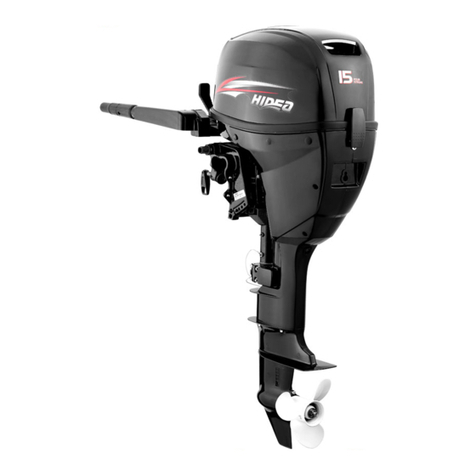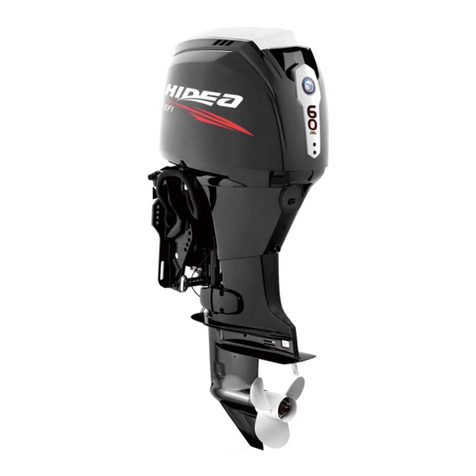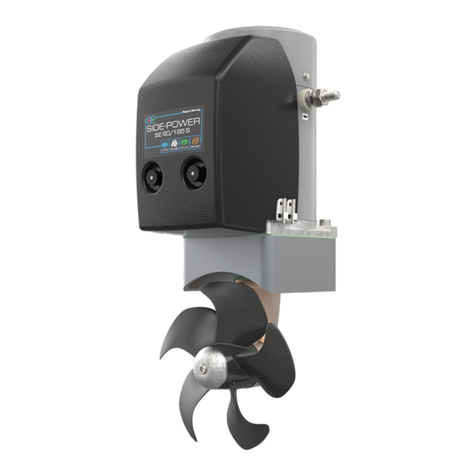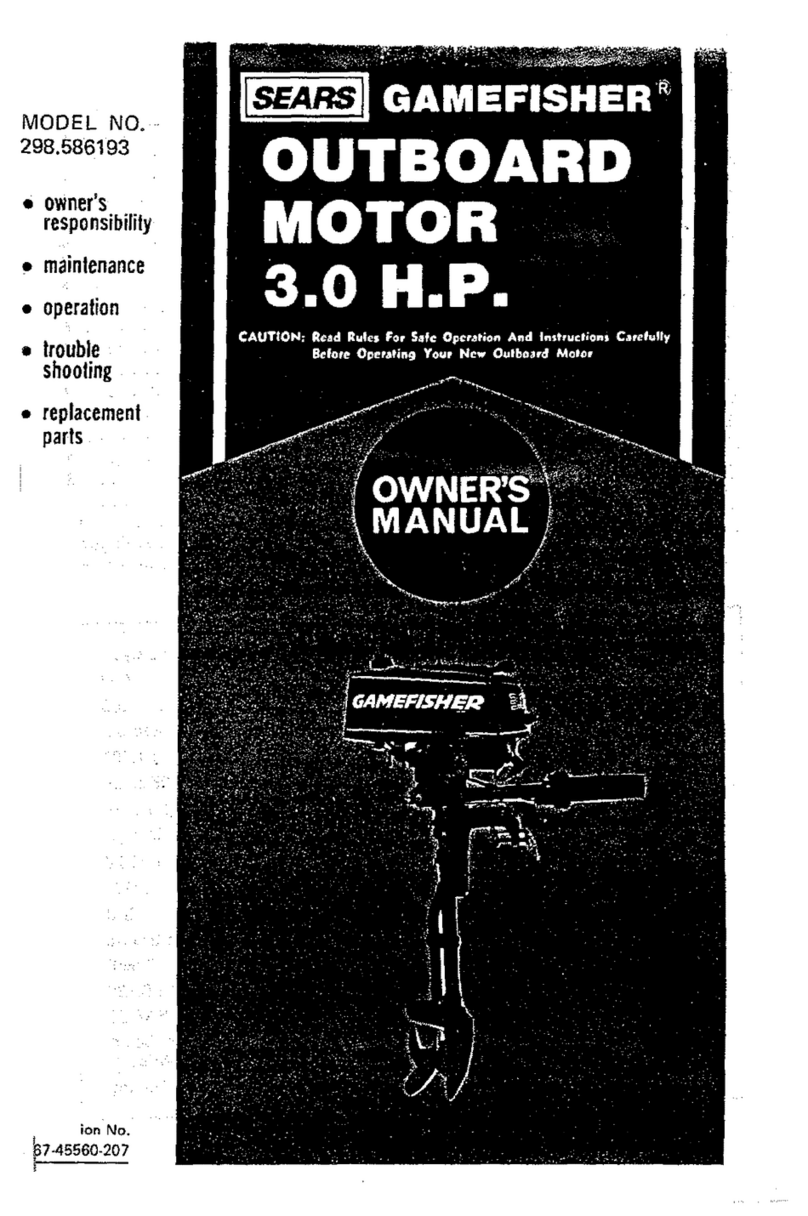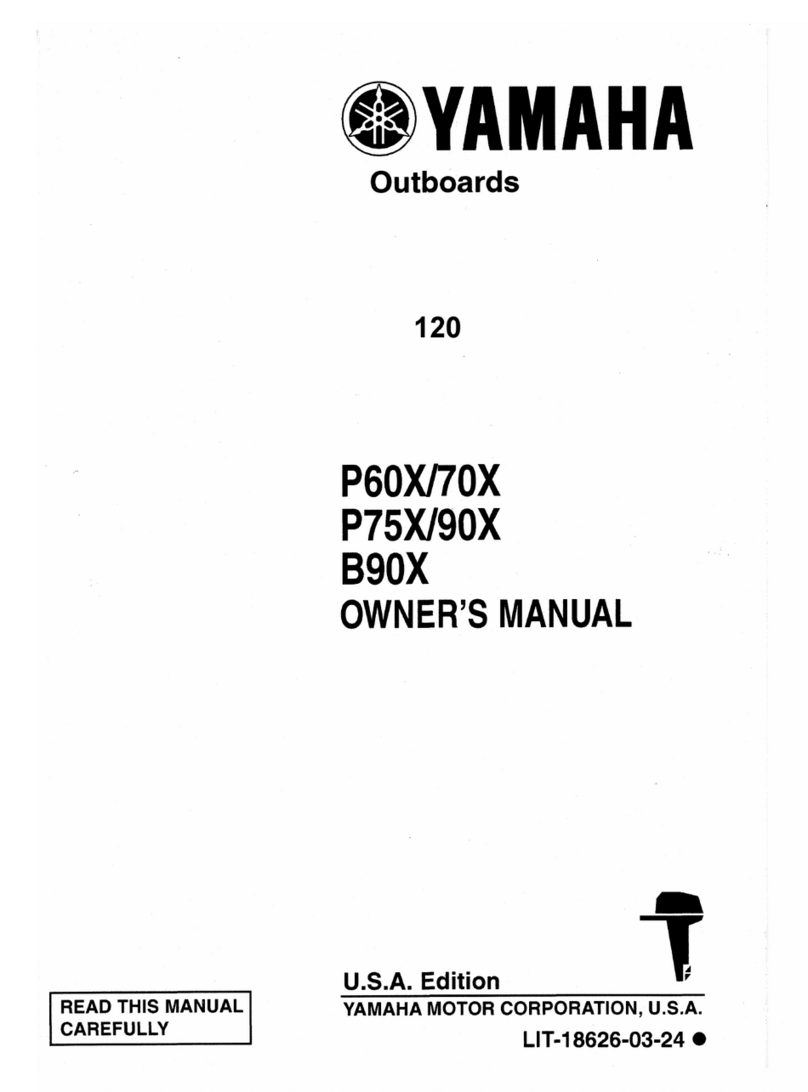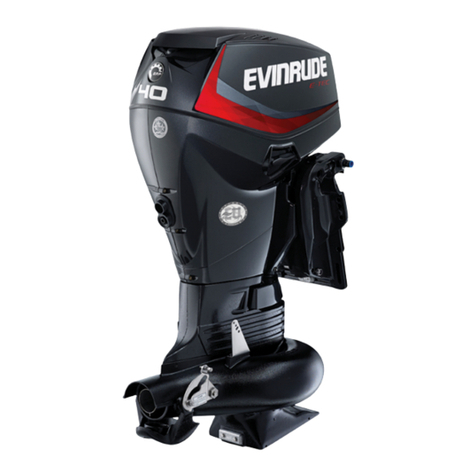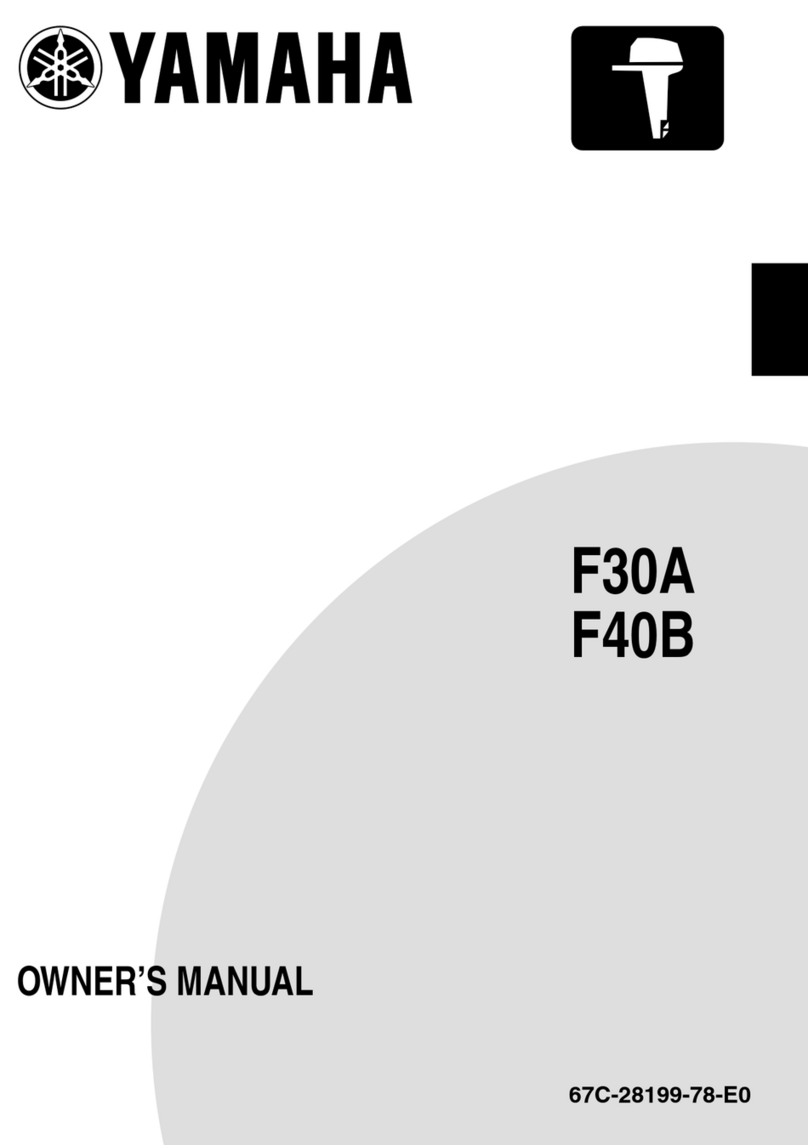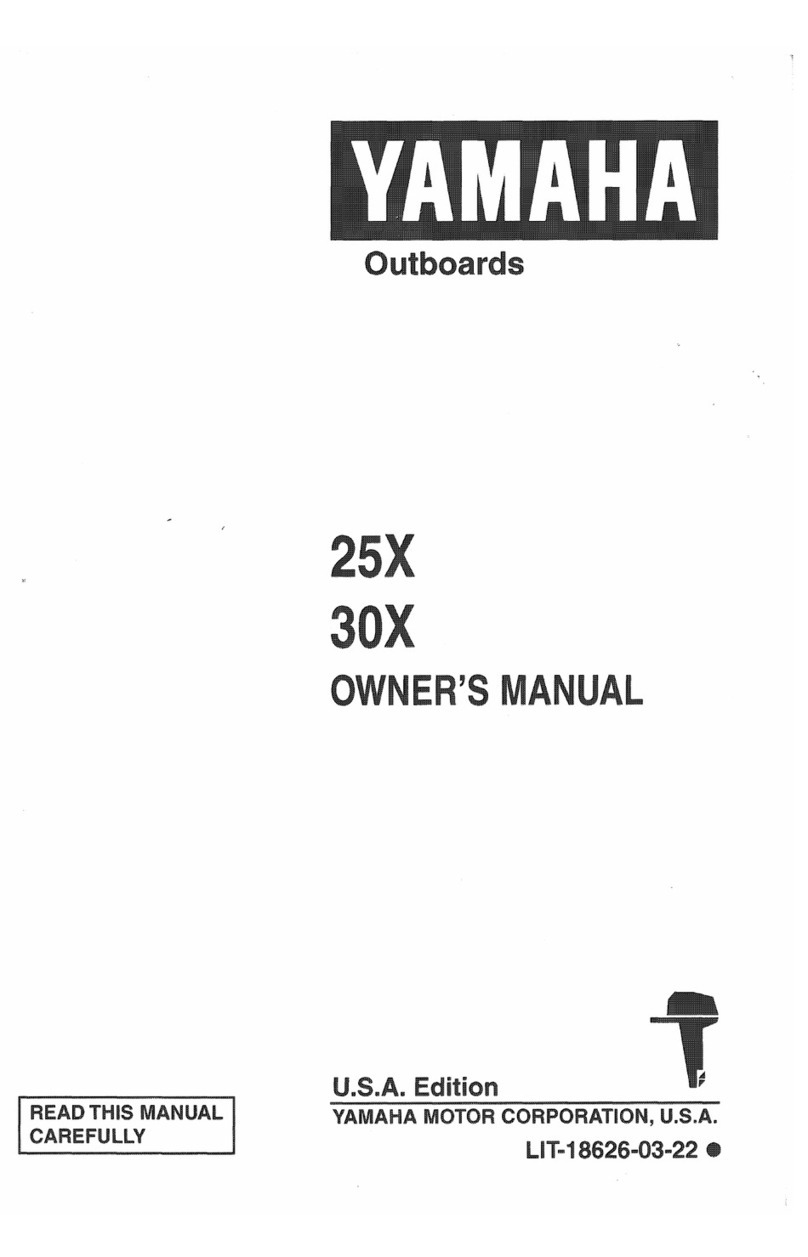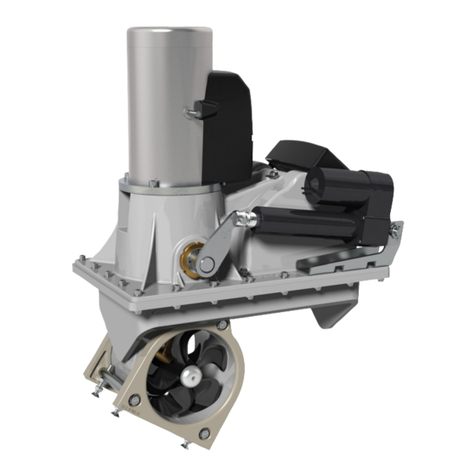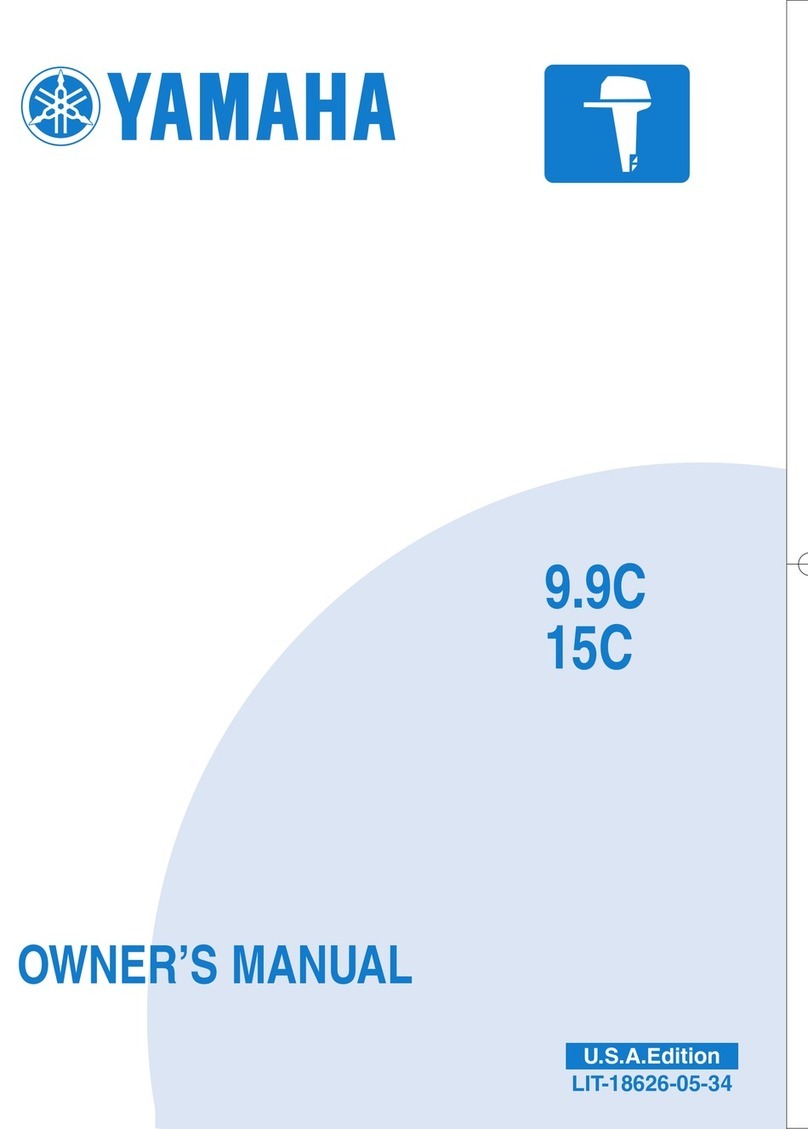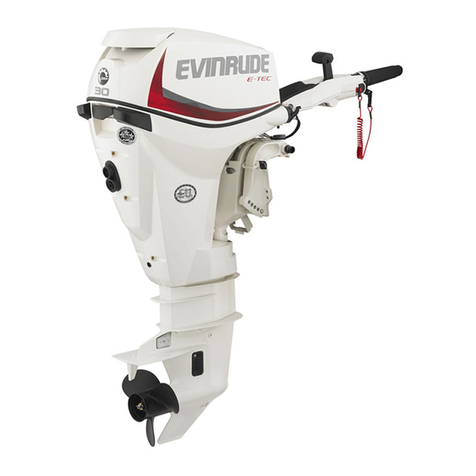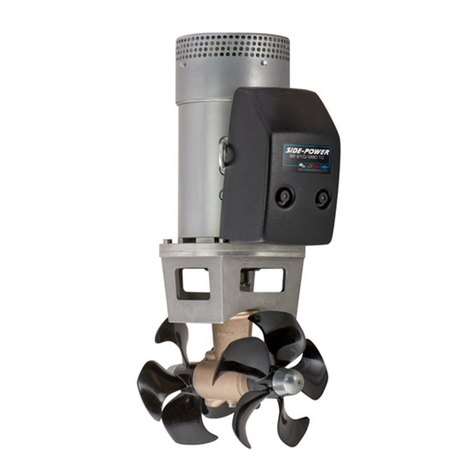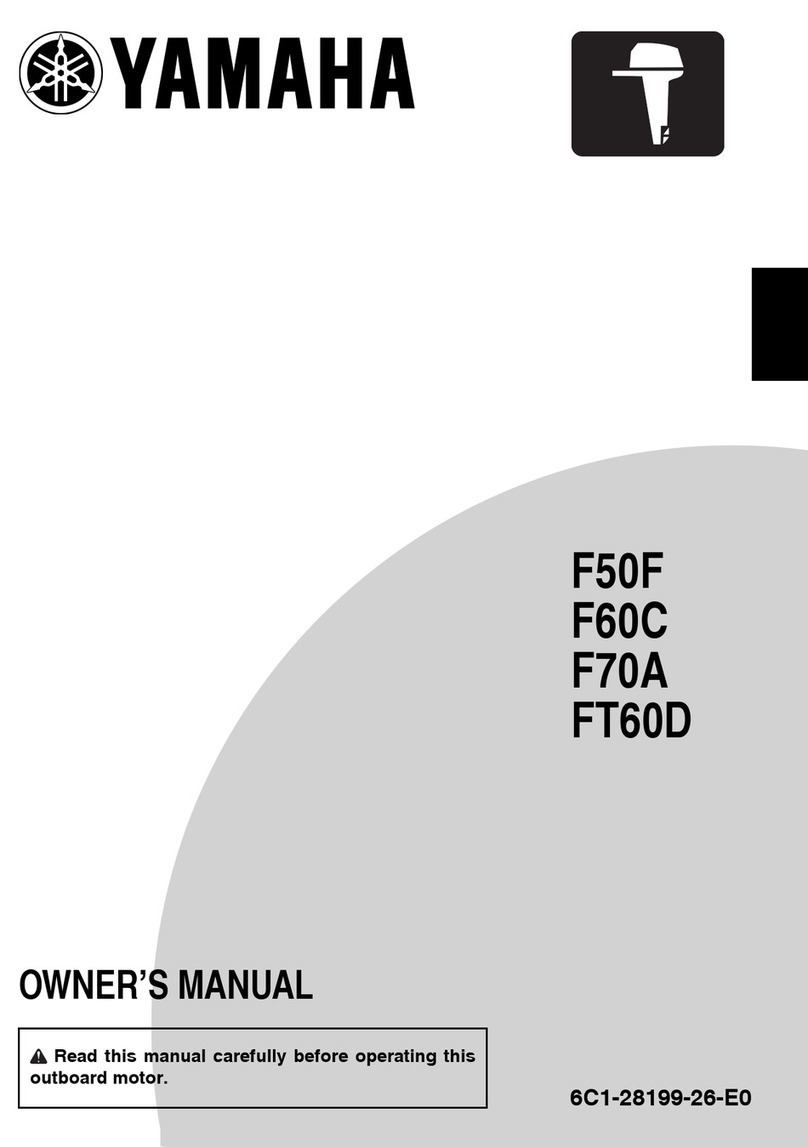Hidea F15 User manual

F15
F20
OWNER’S
MANUAL
Read
this
man
ual
carefull
y
bef
ore
operating
this
outboard motor


Read this manual carefully before operating this outboard motor
Keep this manual onboard in a waterproof bag when boating
This manual should stay with the outboard motor if it is sold

WARNING
Important manual information
F15, F20
OWNER’S MANUAL
©2011 b Hangzhou Hidea Power Machiner
Co.,Ltd.
All rights reserved.
An reprinting or unauthorized use
without the written permission of
Hangzhou Hidea Power Machiner Co.,Ltd.
is expressl prohibited.
Printed in China
HD31285
To the owner there is any question concerning this manu-
al, please consult your Hidea dealer.
Than you for selecting a Hidea outboard
motor. This Owner’s Manual contains infor-
mation needed for proper operation,
mainte- nance and care. A thorough
understanding of these simple instructions
will help you ob- tain maximum enjoyment
from your new Hidea. If you have any
question about the operation or
maintenance of your outboard motor,
please consult a Hidea dealer.
In this Owner’s Manual particularly
important information is distinguished in the
following ways.
: This is the safety alert symbol. It is
used to alert you to potential personal injury
hazards. Obey all safety messages that fol-
low this symbol to avoid possible injury or
death.
EWM00781
TIP:
The F15HE, F15H, F15HE/T, F20HE,
F20EHA, F20MHA, F20FE/T, F20HE/T and
the
standard accessories are used as a base
for the explanations and illustrations in this
man- ual. Therefore some items may not
apply to every model.
HD25112
A
WARNING indicates
a
hazardous situa-
tion which, if not avoided, could result in
death or serious injur .
ECM00701
NOTICE
A NOTICE indicates special precautions
that must be taken to avoid damage to
the outboard motor or other propert .
TIP:
A TIP provides ey information to ma e pro-
cedures easier or clearer.
Hidea continually see s advancements in
product design and quality. Therefore, while
this manual contains the most current prod-
uct information available at the time of print-
ing, there may be minor discrepancies
between your machine and this manual. If

Table of contents
Safet information.............................1
Outboard motor safety......................1
Propeller............................................1
Rotating parts....................................1
Hot parts............................................1
Electric shoc .....................................1
Power tilt............................................1
Engine shut-off cord (lanyard)...........1
Gasoline.............................................1
Gasoline exposure and spills.............2
Carbon monoxide..............................2
Modifications......................................2
Boating safety...................................2
Alcohol and drugs..............................2
Personal flotation devices..................2
People in the water............................2
Passengers........................................2
Overloading.......................................2
Avoid collisions..................................3
Weather.............................................3
Accident reporting..............................3
Boat education and training...............3
Passenger training.............................4
Boating safety publications................4
Laws and regulations.........................4
Boating organizations.......................4
Basic boating rules
(Rules of the road)..........................4
Steering and sailing rules and
sound signals..................................4
Rules when encountering vessels.....5
Other special situations.....................6
General information..........................9
Identification numbers record...........9
Outboard motor serial number...........9
Key number.......................................9
Read manuals and labels...............10
Warning labels.................................10
Specifications and requirements...13
Specifications.................................13
Installation requirements................15
Boat horsepower rating...................15
Mounting motor................................15
Remote control requirements.........15
Battery requirements......................16
Specifications of Battery 16
Mounting battery..............................16
Multiple batteries.............................16
Without a rectifier or Rectifier Regulator. 16
Propeller selection..........................16
Start-in-gear protection...................17
Engine oil requirements..................17
Fuel requirements..........................18
Gasoline...........................................18
Gasoline Additives...........................19
Muddy or acidic water.....................19
Anti-fouling paint.............................20
Motor disposal requirements..........20
Emergency equipment....................20
Emission control information..........20
North American models...................20
Star labels........................................21
Components....................................23
Components diagram.....................23
Fuel tan ..........................................24
Fuel joint..........................................25
Fuel gauge.......................................25
Pressure relief tab............................25
Fuel tan cap...................................25
Air vent screw..................................25
Remote control box.........................25
Remote control lever........................25
Neutral interloc trigger...................26
Neutral throttle lever........................26
Tiller handle.....................................26
Gear shift lever................................26
Throttle grip......................................27
Throttle indicator..............................27
Throttle friction adjuster...................27
Engine shut-off cord (lanyard)
and clip..........................................28
Engine stop button...........................28
Manual starter handle......................29
Starter button...................................29
Main switch......................................29
Power tilt switch...............................29
Steering friction adjuster..................30
Trim tab............................................31
Trim rod (tilt pin)...............................31

Table of contents
Tilt loc mechanism.........................31
Tilt support nob..............................32
Tilt support bar.................................32
Power tilt unit...................................32
Cowling loc lever (pull up type)......33
Flushing device................................33
Alert indicator...................................33
Instruments and indicators............34
Indicators........................................34
Low oil pressure-alert indicator........34
Overheat-alert indicator...................34
Engine control s stem....................35
Alert system....................................35
Overheat alert..................................35
Low oil pressure alert.......................35
Installation.......................................37
Installation......................................37
Mounting the outboard motor...........37
Clamping the outboard motor..........39
Operation.........................................40
First-time operation.........................40
Fill engine oil....................................40
Brea ing in engine...........................40
Getting to now your boat................40
Chec s before starting engine........40
Fuel level.........................................40
Remove the top cowling..................41
Fuel system.....................................41
Controls...........................................41
Engine shut-off cord (lanyard).........42
Engine oil.........................................42
Engine..............................................43
Flushing device................................43
Install top cowling............................43
Chec ing power tilt system..............43
Battery.............................................44
Filling fuel.......................................44
Operating engine............................46
Sending fuel (portable tan ).............46
Starting engine.................................48
Chec s after starting engine...........53
Cooling water...................................53
Warming up engine........................54
Manual start and electric start
models...........................................54
Chec s after engine warm up.........54
Shifting.............................................54
Stop switches...................................54
Shifting...........................................54
Stopping boat.................................56
Stopping engine.............................56
Procedure........................................56
Trimming outboard motor...............57
Adjusting trim angle for manual
tilt models......................................58
Adjusting trim angle
(power tilt models).........................58
Adjusting boat trim...........................59
Tilting up and down........................60
Procedure for tilting up
(manual tilt models).......................60
Procedure for tilting up
(power tilt models).........................61
Procedure for tilting down
(manual tilt models).......................63
Procedure for tilting down
(power tilt models).........................63
Shallow water.................................64
Cruising in shallow water
(manual tilt models).......................64
Power tilt models.............................65
Cruising in other conditions............66
Maintenance.....................................67
Transporting and storing
outboard motor.............................67
Dismounting the outboard motor.....67
Storing outboard motor....................68
Procedure........................................69
Lubrication.......................................70
Cleaning and anticorrosion
measures.......................................70
Flushing power unit.........................70
Cleaning the outboard motor...........71
Chec ing painted surface of
outboard motor..............................71
Periodic maintenance.....................71
Replacement parts...........................72
Maintenance interval guidelines......72
Maintenance chart 1........................73

Table of contents
Maintenance chart 2........................75
Greasing..........................................76
Cleaning and adjusting spar
plug................................................77
Chec ing fuel filter...........................78
Inspecting idle speed.......................78
Changing engine oil.........................79
Inspecting wiring and connectors....80
Chec ing propeller...........................81
Removing propeller..........................81
Installing propeller............................82
Changing gear oil.............................82
Inspecting and replacing
anode(s)........................................83
Chec ing battery
(for electric start models)...............84
Connecting the battery.....................84
Disconnecting the battery................85
Trouble Recover ............................86
Troubleshooting..............................86
Temporary action in emergency.....89
Impact damage................................89
Replacing fuse.................................89
Power tilt will not operate.................90
Starter will not operate.....................90
Emergency starting engine
(manual starter model)..................91
Emergency starting engine
(electric start model)......................92
Treatment of submerged motor......94

Safet information
Outboard motor safet
Observe these precautions at all times.
Propeller
People can be injured or illed if they come
in contact with the propeller. The propeller
can eep moving even when the motor is in
neutral, and sharp edges of the propeller
can cut even when stationary.
Stop the engine when a person
is in the water near you.
Keep people out of reach of the
propeller, even when the engine is off.
Rotating parts
Hands, feet, hair, jewelry, clothing, PFD
straps, etc. can become entangled with
inter- nal rotating parts of the engine,
resulting in serious injury or death.
Keep the top cowling in place whenever
pos- sible. Do not remove or replace the
cowling with the engine running.
Only operate the engine with the cowling
re- moved according to the specific
instructions in the manual. Keep hands,
feet, hair, jewel- ry, clothing, PFD straps,
etc. away from any exposed moving parts.
Hot parts
During and after operation, engine parts are
hot enough to cause burns. Avoid touching
any parts under the top cowling until the en-
gine has cooled.
Electric shock
Do not touch any electrical parts while start-
ing or operating the engine. They can
cause shoc or electrocution.
Power tilt
Body parts can be crushed between the
mo-
tor and the clamp brac et when the motor is
trimmed or tilted. Keep body parts out of
this area at all times. Be sure no one is in
this area before operating the power tilt
mecha- nism.
The power tilt switches operate even when
the main switch is off. Keep people be away
from the switches whenever wor ing around
the motor.
Never get under the lower unit while it is tilt-
ed, even when the tilt support lever or nob
is loc ed. Severe injury could occur if the
outboard motor accidentally falls.
Engine shut-off cord (lan ard)
Attach the engine shut-off cord so that the
engine stops if the operator falls overboard
or leaves the helm. This prevents the boat
from running away under power and leaving
people stranded, or running over people or
objects.
Always attach the engine shut-off cord to a
secure place on your clothing or your arm or
leg while operating. Do not remove it to
leave the helm while the boat is moving. Do
not at- tach the cord to clothing that could
tear loose, or route the cord where it could
be- come entangled, preventing it from
function- ing.
Do not route the cord where it is li ely to be
accidentally pulled out. If the cord is pulled
during operation, the engine will shut off
and you will lose most steering control. The
boat could slow rapidly, throwing people
and ob- jects forward.
HD33810
Gasoline
Gasoline and its vapors are highl flam-
mable and explosive. Always, refuel ac-
cording to the procedure on page 46 to
reduce the ris of fire and explosion.

1

Safet information
Gasoline exposure and spills
Ta e care not to spill gasoline. If gasoline
spills, wipe it up immediately with dry rags.
Dispose of rags properly.
If any gasoline spills onto your s in,
immedi- ately wash with soap and water.
Change clothing if gasoline spills on it.
If you swallow gasoline, inhale a lot of
gaso- line vapor, or get gasoline in your
eyes, get immediate medical attention.
Never siphon fuel by mouth.
Carbon monoxide
This product emits exhaust gases which
con- tain carbon monoxide, a colorless,
odorless gas which may cause brain
damage or death when inhaled. Symptoms
include nausea, dizziness, and drowsiness.
Keep coc pit and cabin areas well
ventilated. Avoid bloc ing exhaust outlets.
Modifications
Do not attempt to modify this outboard mo-
tor. Modifications to your outboard motor
may reduce safety and reliability, and
render the outboard unsafe or illegal to use.
Boating safet
This section includes a few of the many im-
portant safety precautions that you should
follow when boating.
Alcohol and drugs
Never operate after drin ing alcohol or
ta ing drugs. Intoxication is one of the most
com- mon factors contributing to boating
fatalities.
Personal flotation devices
Have an approved personal flotation device
(PFD) on board for every occupant. Hidea
recommends that you must wear a PFD
whenever boating. At a minimum, children
and non-swimmers should always wear
PFDs, and everyone should wear PFDs
when there are potentially hazardous boat-
ing conditions.
People in the water
Always watch carefully for people in the wa-
ter, such as swimmers, s iers, or divers,
whenever the engine is running. When
someone is in the water near the boat, shift
into neutral and stop the engine.
Stay away from swimming areas.
Swimmers can be hard to see.
The propeller can eep moving even when
the motor is in neutral. Stop the engine
when a person is in the water near you.
Passengers
Consult your boat manufacturer’s instruc-
tions for details about appropriate
passenger locations in your boat and be
sure all pas- sengers are positioned
properly before ac- celerating and when
operating above an idle speed. Standing or
sitting in non-designated locations may
result in being thrown either overboard or
within the boat due to waves, wa es, or
sudden changes in speed or direc- tion.
Even when people are positioned prop- erly,
alert your passengers if you must ma e any
unusual maneuver. Always avoid jump- ing
waves or wa es.
Overloading
Do not overload the boat. Consult the boat
capacity plate or boat manufacturer for
max- imum weight and number of
passengers. Be sure that weight is properly
distributed ac- cording to the boat
manufacturers instruc- tions. Overloading or
incorrect weight distribution can
compromise the boats han- dling and lead
to an accident, capsizing or

2

Safet information
swamping.
Avoid collisions
Scan constantly for people, objects, and
oth- er boats. Be alert for conditions that
limit your visibility or bloc your vision of
others.
ZMU06025
Operate defensively at safe speeds and
eep a safe distance away from people, ob-
jects, and other boats.
Do not follow directly behind
other boats or waters iers.
Avoid sharp turns or other
maneuvers that ma e it hard for others to
avoid you or un- derstand where you are
going.
Avoid areas with submerged
objects or shallow water.
Ride within your limits and avoid
aggres- sive maneuvers to reduce the
ris of loss of control, ejection, and
collision.
Ta e early action to avoid
collisions. Re- member, boats do not
have bra es, and stopping the engine or
reducing throttle can reduce the ability to
steer. If you are not sure that you can
stop in time before hitting an obstacle,
apply throttle and turn in another
direction.
Weather
Stay informed about the weather. Chec
weather forecasts before boating. Avoid
boating in hazardous weather.
Accident reporting
Boat operators are required by law to file a
Boating Accident Report with their state
boating law enforcement agency if their
boat is involved in any of the following
accidents:
1. There is loss of life or probable loss of
life.
2. There is personal injury that requires
medical attention beyond first aid.
3. There is property damage to boats or
other property over a certain amount.
4. There is complete loss of a boat.
Contact local law enforcement personnel if
a report is necessary.
Boat education and training
Operators should ta e a boating safety
course. This may be required in your state.
Many of the organizations listed in the next
section can provide information about
cours- es in your area.
You may also want to consider an Internet-
based program for basic boater education.
The Online Boating Safety Course provided
by the BoatU.S. Foundation, is approved by
the National Association of State Boating
Law Administrators (NASBLA) and recog-
nized by the United States Coast Guard.
Most, but not all, states accept this course
to meet their minimum requirements. While
it cannot replace an in-depth course such
as one offered by the U.S. Coast Guard,
U.S. Power Squadron, or other
organization, this online course does
provide a general over- view of the basics in
boating safety, require- ments, navigation,
and operation. Upon successful completion
of the course, the user can download a
certificate of comple- tion immediately or,
for a small charge, re- quest one by mail. To
ta e this free course, go to boatus.org.

3

Safet information
Passenger training
Ma e sure at least one other passenger is
trained to operate the boat in the event of
an emergency.
Boating safet publications
Be informed about boating safety.
Additional publications and information can
be obtained from many boating
organizations.
Laws and regulations
Know the marine laws and regulations
where you will be boating- and obey them.
Several sets of rules prevail according to
geographic location, but all are basically the
same as the International Rules of the
Road. The rules presented in the following
section are con- densed- and have been
provided for your convenience only.
Contact the U.S. Coast Guard, the National
Association of State Boating Law Adminis-
trators, or your local Power Squadron for a
complete set of rules governing the waters
in which you will be using your boat.
Boating organizations
The following organizations provide boating
safety training and information about
boating safety and laws.
United States Coast Guard
Consumer Affairs Staff (G-BC)
Office of Boating, Public, and Consumer Af-
fairs
U.S. Coast Guard Headquarters
Washington, D.C. 20593-0001
http://www.uscgboating.org/
United States Power Squadrons
1-888-FOR-USPS (1-888-367-8777)
http://www.usps.org/
Boat Owners Association of The United
States
1-800-336-BOAT (1-800-336-2628)
http://www.boatus.com/
National Association of State Boating
Law Administrators (NASBLA)
1500 Leestown Road, Suite 330
Lexington, KY 40511 859-225-9497
http://www.nasbla.org/
National Marine Manufacturers Associa-
tion (NMMA)
200 East Randolph Drive
Suite 5100
Chicago, IL 60601
http://www.nmma.org/
Marine Retailers Association of America
155 N. Michigan Ave. Chicago,
IL 60304
http://www.mraa.com/
Basic boating rules (Rules of
the road)
Just as there are rules that apply when you
are driving on streets and highways, there
are waterway rules that apply when you are
driving your boat. These rules are used
inter- nationally. (For U.S.A.: and are also
en- forced by the United States Coast
Guard and local agencies.) You should be
aware of these rules, and follow them
whenever you encounter another vessel on
the water.
Steering and sailing rules and sound
signals
Whenever two vessels on the water meet
one another, one vessel has the right-of-

4

Safet information
way; it is called the “stand-on” vessel. The
vessel that does not have the right-of-way
is called the “give-way” or
“burdened”vessel. These rules determine
which vessel has the right-of-way, and what
each vessel should do.
Stand-on vessel
The vessel with the right-of-way has the
duty to continue its course and speed,
except to avoid an immediate collision.
When you maintain your direction and
speed, the other vessel will be able to
determine how best to avoid you.
Give-wa vessel
The vessel that does not have the right-of-
way has the duty to ta e positive and timely
action to stay out of the way of the Stand-
On vessel. Normally, you should not cross
in front of the vessel with the right-of-way.
You should slow down or change directions
brief- ly and pass behind the other vessel.
You should always move in such a way that
the operator of the other vessel can see
what you are doing.
“ The general prudential rule ”
This rule is called Rule 2 in the International
Rules and says,
“ In obeying and construing these rules due
regard shall be had to all dangers of
naviga- tion and collision, and to any
special circum- stances, which may render
a departure from the above rules necessary
in order to avoid immediate danger.”
In other words, follow the standard rules ex-
cept when a collision will occur unless both
vessels try to avoid each other. If that is the
case, both vessels become “ Give-Way ”
vessels.
Rules when encountering vessels
There are three main situations that you
may encounter with other vessels which
could lead to a collision unless the Steering
Rules are followed:
Meeting: (you are approaching another ves-
sel head-on)
Crossing: (you are traveling across the oth-
er vessel’s path)
Overtaking: (you are passing or being
passed by another vessel)
In the following illustration, your boat is in
the center. You should give the right-of-way
to any vessels shown in white area (you are
the Give-Way vessel). Any vessels in the
shad- ed area must yield to you (they are
the Give- Way vessels). Both you and the
meeting vessel must alter course to avoid
each other.
Meeting
If you are meeting another power vessel
head on, and are close enough to run the
ris of collision, neither of you has the right-
of- way Both of you should alter course to
avoid an accident. You should eep the
other ves- sel on your port (left) side. This
rule doesn’t apply if both of you will clear
one another if you continue on your set
course and speed.
5

Safet information
Crossing
When two power driven vessels are
crossing each other’s path close enough to
run the ris of collision, the vessel which
has the oth- er on the starboard (right) side
must eep out of the way of the other. If the
other vessel is on your right, you must eep
out of its way; you are the Give-Way vessel.
If the other vessel is on your port (left) side,
remember that you should maintain course
and direc- tion, provided the other vessel
gives you the right-of-way as it should.
Overtaking
If you are passing another vessel, you are
the “Give-Way” vessel. This means that the
other vessel is expected to maintain its
course and speed. You must stay out of its
way until you are clear of it. Li ewise, if an-
other vessel is passing you, you should
maintain your speed and direction so that
the other vessel can steer itself around you.
Other special situations
There are three other rules you should be
aware of when driving your boat around
oth- er vessels.
Narrow channels and bends
When navigating in narrow channels, you
should eep to the right when it is safe and
practical to do so. If the operator of a
power- driven vessel is preparing to go
around a bend that may obstruct the view of
other wa- ter vessels, the operator should
sound a pro- longed blast on the whistle (4
to 6 seconds). If another vessel is around
the bend, it too should sound the whistle.
Even if no reply is heard, however, the
vessel should still pro- ceed around the
bend with caution. If you navigate such
waters with your boat, you will need to carry
a portable air horn, available from local
marine supply stores.
Fishing vessel right-of-wa
All vessels that are fishing with nets, lines or
trawls are considered to be “fishing vessels”
under the International Rules. Vessels with
trolling lines are not considered fishing ves-
sels. Fishing vessels have the right-of-way
regardless of position. Fishing vessels can-
not, however, impede the passage of other
vessels in narrow channels.
Sailing vessel right-of-wa
Sailing vessels should normally be given the
right-of-way. The exceptions to this are:
1. When the sailing vessel is overta ing
the power-driven vessel, the power-
driven vessel has the right-of-way.
2. Sailing vessels should eep clear of
any fishing vessel.
3. In a narrow channel, a sailing vessel
should not hamper the safe passage of
a power-driven vessel that can navigate
only in such a channel.
6

Safet information
Reading buo s and other markers
The waters of the United States are mar ed
for safe navigation by the lateral system of
buoyage. Simply put, buoys and mar ers
have an arrangement of shapes, colors,
numbers and lights to show which side of
the buoy a boater should pass on when
navigat- ing in a particular direction. The
mar ings on these buoys are oriented from
the perspec- tive of being entered from
seaward (the boat- er is going towards the
port). This means that red buoys are
passed on the starboard (right) side when
proceeding from open wa- ter into port, and
blac buoys are to port (left) side. When
navigating out of port, your posi- tion with
respect to the buoys should be re- versed;
red buoys should be to port and blac
buoys to starboard.
Many bodies of water used by boaters are
entirely within the boundaries of a particular
state. The Uniform State Waterway Mar ing
System has been devised for these waters.
This system uses buoys and signs with dis-
tinctive shapes and colors to show
regulatory or advisory information. These
mar ers are white with blac letters and
orange boarders. They signify speed zones,
restricted areas, danger areas, and general
information.
Remember, mar ings may vary by geo-
graphic location. Always consult local boat-
ing authorities before driving your boat in
unfamiliar waters.

7

Safet information
ZMU01708
8
Other manuals for F15
1
This manual suits for next models
1
Table of contents
Other Hidea Outboard Motor manuals

